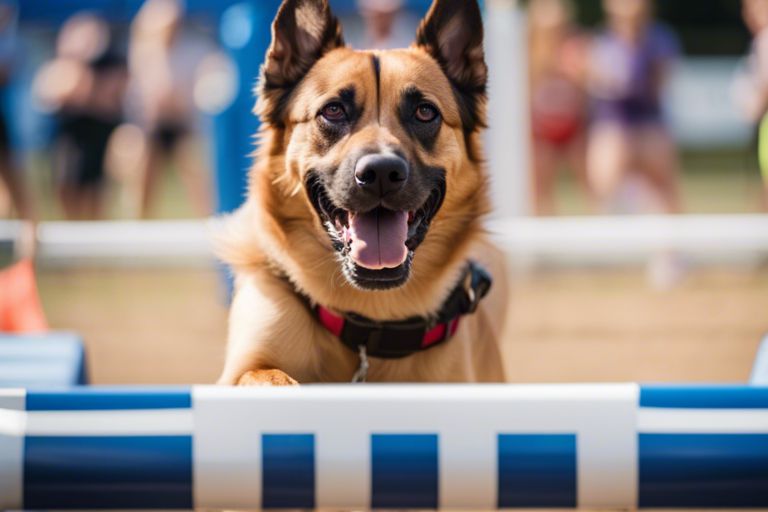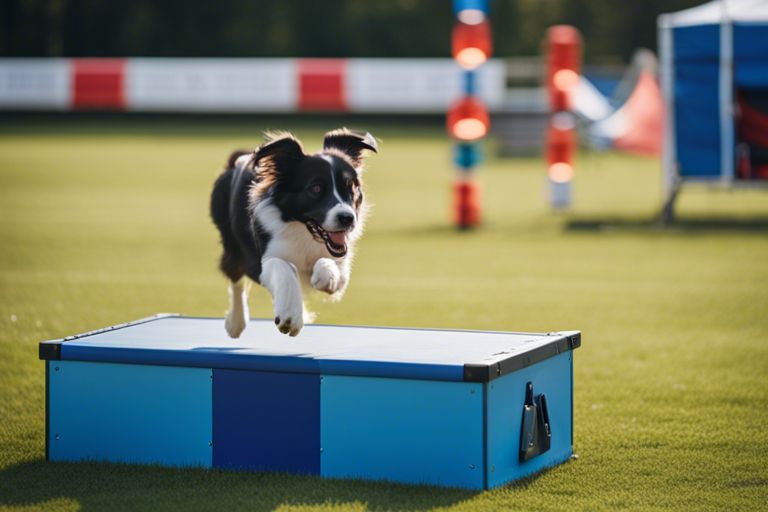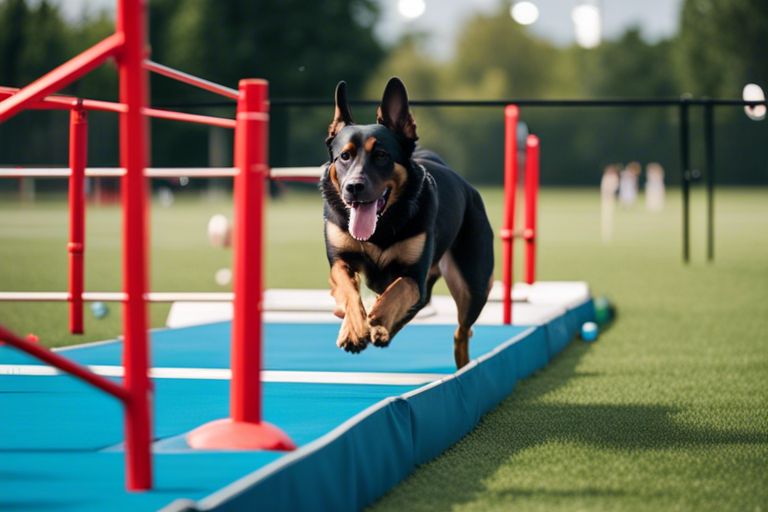This guide will walk you through the process of constructing a safe and sturdy flyball box for your furry champion. A flyball box is an important piece of equipment for training and competing in the thrilling sport of flyball. With detailed instructions and important safety tips, you’ll be able to create a high-quality flyball box that will withstand the fast-paced action of this exciting dog sport.

Understanding Flyball Boxes for Dogs
Before exploring into building a flyball box, it’s crucial to understand the different types available in the market.
Types of Flyball Boxes
There are mainly two types – spring-loaded boxes and pedal-activated boxes. Spring-loaded boxes release balls when the dog presses the front panel, while pedal-activated boxes require the dog to step on a pedal to release the ball. Any good flyball box should have a reliable ball release mechanism to ensure fair play during training or competitions.
| Spring-Loaded Boxes | Pedal-Activated Boxes |
| Release balls when the dog presses a front panel | Require dog to step on the pedal to release the ball |
| Commonly used for training purposes | Popular in competitive flyball |
| Easy for dogs to learn and operate | Provides precise control over ball release |
| May have adjustable spring tension | Requires training for dogs to use effectively |
Importance of Building a Customized Box
Understanding the importance of building a customized flyball box for dogs is crucial for their safety and performance. A customized box allows you to cater to your dog’s specific needs and abilities, ensuring optimal training and performance. It also reduces the risk of injury and helps in maintaining consistency in their training routine. By creating a box that suits your dog’s preferences, you can motivate them to excel in flyball competitions while keeping them safe.
Factors to Consider When Building a Flyball Box
Some important factors to consider when building a flyball box for dogs include:
- Space and Portability
- Dog Size and Breed
- Material Selection and Durability
- Safety Features and Regulations
After considering these factors, you can create a functional and safe flyball box for your furry friends.
Space and Portability
Clearly, when building a flyball box, consider the space available for the equipment and how portable you need it to be for transport to different locations.
Dog Size and Breed
There’s more to selecting the right size for your flyball box than just considering your dog’s breed. Factors like their agility level and comfort with the box also play a crucial role.
Material Selection and Durability
Now, when choosing materials for your flyball box, opt for sturdy and durable options that can withstand the wear and tear of repeated use by energetic dogs.
The durability of the materials used can impact the longevity of your flyball box and ensure the safety of your dogs during training and competitions.
Safety Features and Regulations
If safety features are not incorporated into your flyball box, there is a risk of injury to the dogs during training or competition. Abiding by regulations ensures a safe environment for all participants.
A well-designed box with safety features such as non-slip surfaces, smooth edges, and proper height can prevent accidents and injuries, making the training experience more positive for both dogs and handlers.
Tips for Building a Successful Flyball Box
Despite the apparent simplicity of a flyball box, there are several factors to consider to ensure it is built correctly and effectively. Here are some tips to help you create a successful flyball box:
- Measuring and Designing: Ensure precise measurements and design to meet standard requirements for a flyball box.
- Choosing the Right Materials and Tools: Select sturdy materials like wood or PVC and gather proper tools such as saws and drills.
- Considering the Dog’s Comfort and Ease of Use: Design the box with the dog’s safety and comfort in mind.
Measuring and Designing the Box
Even before picking up the tools, accurate measurements and a well-thought-out design are crucial for creating a functional and safe flyball box.
Choosing the Right Materials and Tools
Measuring and choosing the right materials and tools is crucial to building a durable and long-lasting flyball box. Make sure to select sturdy materials like wood or pvc and have the necessary tools like saws and drills on hand.
Tips: Research the best materials for durability and weight requirements. Prioritize safety by avoiding sharp edges and using non-toxic materials.
Considering the Dog’s Comfort and Ease of Use
Designing the flyball box with the dog’s comfort and safety in mind is key. Ensure smooth surfaces and secure edges to prevent injuries during training and competitions.

Step-by-Step Guide to Building a Flyball Box
For dog enthusiasts looking to build their own flyball box, here is a step-by-step guide to help you create your very own at-home training equipment.
| Cutting and Assembling the Frame | Attaching the Catch and Release Mechanism |
StepbyStepStart by cutting the wooden pieces according to the measurements in your plan. Assemble the frame using screws and wood glue for added stability. |
MechanismAttach the catch and release mechanism securely to the frame. This mechanism is crucial for releasing the ball when the dog triggers it, making it a necessary part of the flyball box. |
For instance, the catch and release mechanism can be made using a simple spring-loaded latch that is triggered by the pressure of the ball against it. Make sure it is sturdy and operates smoothly to ensure seamless ball release.
| Adding the Ball Return System | Finishing Touches and Decorations |
BuildingConstruct a ball return system that guides the ball back to the front of the box after each launch. This will save time and energy for both you and your furry friend during training sessions. |
OneAdd some finishing touches and decorations to personalize your flyball box. Consider painting it in vibrant colors or adding your dog’s name for a personalized touch. |
Another important aspect to consider is to ensure all edges are smooth and there are no sharp corners that could potentially harm your dog during training. Safety should always be a top priority when building and using a flyball box.
Pros and Cons of Building a Custom Flyball Box
| Pros | Cons |
| Allows for customization to fit your dog’s specific needs | Requires time and effort to build |
| Can save money compared to purchasing a pre-made box | May not have the same durability as commercial options |
| Opportunity to personalize the design | Could potentially lack professional finishing touches |
| Great way to engage in a DIY project | May not have access to quality materials |
| Understanding how the box works by building it yourself | Does not come with a warranty like commercial options |
Advantages of Customization
With a custom flyball box, you can tailor the design to meet your dog’s specific needs and preferences. This level of customization ensures that your furry friend gets the most out of their training while also allowing you to showcase your creativity.
Disadvantages of DIY Construction
Disadvantages of building a custom flyball box include the time and effort required to construct it, as well as the potential lack of durability compared to commercial options. While engaging in a DIY project can be rewarding, it is crucial to consider these drawbacks before starting.
Comparing Custom to Commercial Options
| Custom Flyball Box | Commercial Flyball Box |
| Allows for personalization | Ready-made for immediate use |
| Potential cost savings | Generally higher durability |
| Engaging DIY project | Comes with warranty |
For instance, custom flyball boxes offer the flexibility of personalization and potential cost savings, but they may lack the durability and warranty that come with commercial options. It’s crucial to weigh these factors carefully before making a decision on which type of flyball box to choose.

Troubleshooting Common Issues
Dealing with Mechanical Failures
Not all builds go smoothly, and sometimes mechanical failures can occur with your flyball box. Some important things to check for are loose screws, misaligned components, or worn-out parts that may need replacing. Regular maintenance can help prevent these issues, but having spare parts on hand can also be helpful in quickly resolving any unexpected mechanical failures.
Addressing Dog Training and Behavior Issues
On occasion, your dog may struggle with using the flyball box correctly. This can be due to a variety of reasons, such as fear of the box, lack of motivation, or confusion about the task. It’s vital to address these issues through positive reinforcement training, building your dog’s confidence, and ensuring that the box is set up correctly for them to succeed. Patience and consistency are key to overcoming these challenges.
Maintaining and Repairing the Box
Common wear and tear can affect the functionality of your flyball box over time. This can include frayed ropes, worn-out springs, or damaged triggers. Regularly inspecting and maintaining your box can help prevent more significant issues from arising. If repairs are needed, follow the manufacturer’s guidelines or seek professional help to ensure that your flyball box remains in top condition for your dog’s training and enjoyment.
Troubleshooting these common issues can help ensure that your dog’s training sessions are smooth and successful, allowing them to have fun while improving their skills in the flyball sport.
Frequently Asked Questions
What materials do I need to build a flyball box for dogs?
To build a flyball box for dogs, you will need the following materials:
- Wood (plywood is commonly used)
- PVC pipes or tubes
- Carpet or rubber matting
- Nails, screws, and glue
- Measuring tape, saw, and drill
How do I build the actual flyball box structure?
To build the flyball box structure, follow these steps:
- Cut the plywood into the desired dimensions for the box.
- Assemble the box by nailing or screwing the pieces together.
- Attach the PVC pipes or tubes for the dog to trigger the ball release mechanism.
How can I train my dog to use the flyball box?
To train your dog to use the flyball box, follow these tips:
- Introduce your dog to the box slowly and positively with treats and praise.
- Teach your dog to paw or press the PVC pipe to release the ball.
- Practice with your dog regularly, gradually increasing speed and distance.
To wrap up,
The process of creating a flyball box for dogs requires some basic woodworking skills and dedication. By following the steps outlined in this guide, you can build a customized flyball box that suits your dog’s needs and helps improve their skills in this exciting canine sport. Remember to prioritize safety and ensure the box is sturdy and well-constructed to withstand the high-energy activities involved in flyball competitions. Enjoy the process of building and training your dog with their new flyball box!
